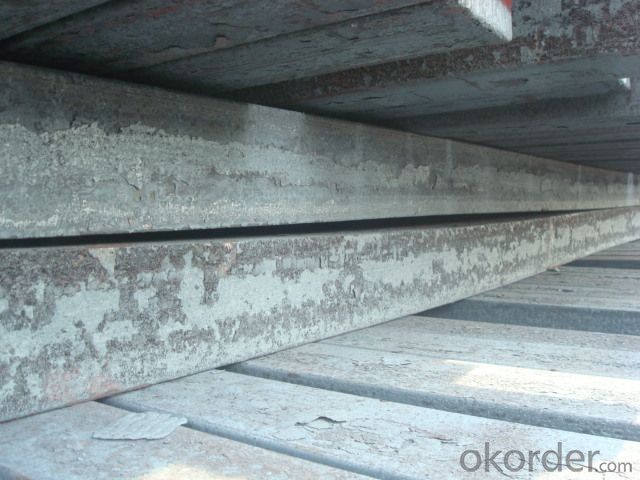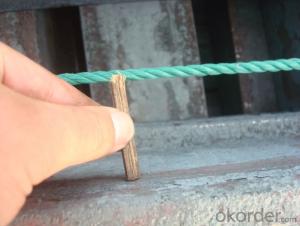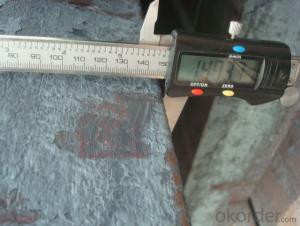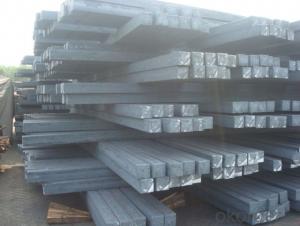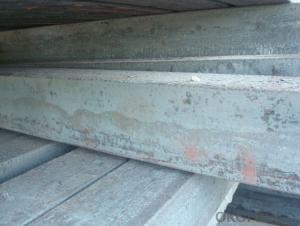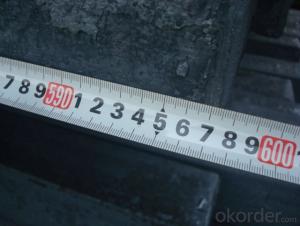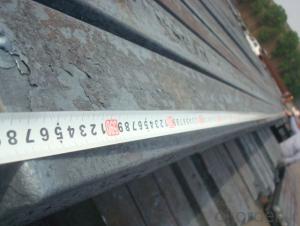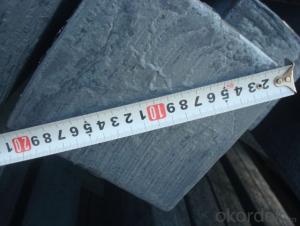Continue Casting Steel Bloom Made by Blasting Furnace
- Loading Port:
- Tianjin
- Payment Terms:
- TT OR LC
- Min Order Qty:
- 1000 m.t.
- Supply Capability:
- 100000 m.t./month
OKorder Service Pledge
OKorder Financial Service
You Might Also Like
Continue Casting Steel Bloom Made by Blasting Furnace
1.Structure of Continue Casting Steel Bloom Made by Blasting Furnace
Continue Casting Steel Bloom Made by Blasting Furnace
Steel ingot by cogging or breakdown of semi-finished products, is the raw material of all kinds of steel mill.Billet section of square, round, flat, rectangular and abnormity, etcSeveral, mainly related to shape of rolled products.Simple rolled section steel, choose close to finished product cross section of square billet or rectangular billet.rollingThe sector products such as flat steel, Angle steel, select the rectangular billet or slab.Had better profiled billet when production beams, channels, and in rolling processLines and improve the yield.The raw material of round billet is the production of seamless tube.See billet production billet production methods. Billet section size should meet the requirements of rolling deformation and finished product quality, but also roll strength and biting condition of restrictions.General steelBillet section heightH.And the roll diameterDThe ratio of the(namelyH/D)Should be less than or equal to zero0.5.Length of steel billet by finishing temperature,Rolling time and the length of the productOr times ruler.When heated too long accident prone to bump the furnace wall of steel, too short, furnace bottom utilization rate is not high, influence the heating furnace production.For the productionChoose a variety of steel and steel billet, should consider the affinities of billet, as far as possible in order to improve the productivity of the roughing mill, simplify the stock management of workshop.
2.Main Features of Continue Casting Steel Bloom Made by Blasting Furnace.
Continue Casting Steel Bloom Manufactured by Blasting Furnace section size should meet the requirements of rolling deformation and finished product quality, but also roll strength and biting condition of restrictions. General steel Billet section height H. And the roll diameter D The ratio of the ( namely H/D) Should be less than or equal to zero 0.5 . Length of steel billet by finishing temperature, Rolling time and the length of the product Or times ruler. When heated too long accident prone to bump the furnace wall of steel, too short, furnace bottom utilization rate is not high, influence the heating furnace production. For the production Choose a variety of steel and steel billet, should consider the affinities of billet, as far as possible in order to improve the productivity of the roughing mill, simplify the stock management of workshop.
3. Continue Casting Steel Bloom Made by Blasting FurnaceImages


4. Continue Casting Steel Bloom Made by Blasting Furnace Specification
1)SIZE
2)MATERIAL GRADE
3)CHEMICAL ELEMENTS COMPOSITONS
Material standard The editor Range of thickness: 150-240 - mm + / - 5 mm width range: 880-1530 - mm + / - 20 mm Length: 3700-10000 - mm + / - 500 - mm Cross-sectional size: 64 * 64; 82 * 82; 98 * 98; 124 * 124; 120 * 150; 152 * 164; 152 * 170 mm Length: 9000 mm Section of tolerance: billet: 1.0 + / - 2.0-1.0 + / - 1.0 mm slab: width: + / - 2.0 mm thickness: + / - 3.0 mm The length tolerance: + / - 200 mm Section diagonal tolerance: 3.5-8.0 MM Billet section size protrusions requirements: < 1242 mm, do not allow; > = 1242 mm, < = 2 mm 1242 mm, < = 3 mm Beheading (shear) extension deformation: < 1242 mm billet: no control; The slab: < = 15 mm Surface tilt: no more than billet section 0.1 Bending: every 1 m length is not more than 10 mm The distortion: length < = 5 m, < = 11. ; The length of the < = 7.5 M, < = 5. Material % 3 sp/PS chemical composition: C Mn Si S P
5.FAQ of Continue Casting Steel Bloom Made by Blasting Furnace
We have organized several common questions for our clients,may help you sincerely:
①How to regonized your products when the shipment arrive?
We will marked the painting in the end of the steel billet, and send you the MTC with the heart no. same as marked in the steel billets.
②How many days for the SGS inpecting the quantity and weight?
It depens on the quantity usually it is about 4000tons one day..
③What kinds of the grade you can supply?
We can supply Q195, Q215,Q235 and other kinds of the grade as our customers need.
- Q: What are the main factors affecting the thermal conductivity of steel billets?
- The thermal conductivity of steel billets is primarily influenced by several factors. Firstly, the chemical composition of the steel plays a significant role in determining its thermal conductivity. Elements such as carbon, manganese, and silicon can affect the crystal structure and the arrangement of atoms within the steel, which in turn influences its ability to conduct heat. Generally, steels with a higher carbon content have lower thermal conductivity due to the increased presence of impurities and the formation of non-conductive carbides. Secondly, the microstructure of the steel also affects its thermal conductivity. Heat conduction in steel occurs through the movement of lattice vibrations, known as phonons. The presence of grain boundaries, dislocations, and other defects within the microstructure can impede the phonon movement, resulting in reduced thermal conductivity. Conversely, a more uniform and fine-grained microstructure tends to enhance thermal conductivity. Furthermore, the temperature of the steel billet can significantly impact its thermal conductivity. As the temperature increases, the thermal conductivity of steel generally decreases due to the increased scattering of phonons by lattice vibrations and the accompanying rise in thermal resistance. Another factor that influences the thermal conductivity of steel billets is their physical dimensions, particularly their cross-sectional area and length. The larger the cross-sectional area, the higher the thermal conductivity, as there is more space available for the heat to transfer through. Similarly, longer billets tend to have lower thermal conductivity due to the increased distance over which heat must be conducted. Lastly, the presence of impurities and alloying elements in the steel can also affect its thermal conductivity. For example, alloying elements like nickel, chromium, and copper can alter the crystal structure and lattice vibrations, thereby influencing the thermal conductivity of the steel billet. In summary, the main factors affecting the thermal conductivity of steel billets include the chemical composition, microstructure, temperature, physical dimensions, and the presence of impurities and alloying elements. Understanding these factors is crucial in various industrial applications where heat transfer and thermal management play a critical role.
- Q: What are the main advantages of using steel billets in manufacturing?
- There are several main advantages of using steel billets in manufacturing. Firstly, steel billets are known for their exceptional strength and durability. This makes them ideal for manufacturing various products that require high tensile strength and resistance to wear and tear. Whether it's automotive parts, construction materials, or industrial equipment, steel billets provide the necessary strength and reliability. Secondly, steel billets offer excellent machinability. They can be easily shaped, cut, and formed into different shapes and sizes, making them highly versatile in manufacturing processes. This allows manufacturers to create complex and intricate designs with precision, ensuring the production of high-quality finished goods. Furthermore, steel billets have excellent thermal conductivity and can withstand extreme temperatures. This makes them useful in industries where heat resistance is required, such as in the production of heat exchangers, boilers, and other industrial applications. The ability of steel billets to maintain their structural integrity even under high temperatures makes them highly reliable in demanding manufacturing environments. In addition, steel billets are readily available and cost-effective. Steel is one of the most commonly used materials in manufacturing, making it easily accessible in the market. The abundance of steel billets ensures a consistent supply for manufacturers, reducing production delays and costs associated with sourcing materials. Lastly, steel billets have excellent corrosion resistance. This makes them suitable for manufacturing products that are exposed to harsh environmental conditions or corrosive substances. By using steel billets, manufacturers can ensure that their products maintain their integrity and functionality even in challenging environments. In conclusion, the main advantages of using steel billets in manufacturing include their exceptional strength, machinability, thermal conductivity, availability, cost-effectiveness, and corrosion resistance. These qualities make steel billets a preferred choice for various industries, enabling the production of high-quality, durable, and reliable products.
- Q: What are the different production methods for steel billets?
- There are several different production methods for steel billets, each with its own unique characteristics and advantages. 1. Casting: One of the most common methods is the casting process, where molten steel is poured into a mold and allowed to solidify. This method can be further divided into continuous casting and ingot casting. Continuous casting involves the continuous pouring of molten steel into a water-cooled mold, which results in a continuous solidification process. Ingot casting, on the other hand, involves pouring molten steel into individual molds to create ingots that are then used as raw material for further processing. 2. Direct Reduction: Another method is the direct reduction process, which involves the reduction of iron ore in the presence of a reducing agent such as natural gas or coal. This process produces direct reduced iron (DRI), which can then be used to produce steel billets through subsequent melting and casting processes. 3. Electric Arc Furnace (EAF): The EAF method involves melting scrap steel in an electric arc furnace. This process is commonly used in recycling steel as it allows for the use of various scrap sources, including old cars, appliances, and industrial waste. The molten steel is then cast into billets or other desired shapes. 4. Basic Oxygen Furnace (BOF): The BOF method is a traditional steelmaking process that involves the conversion of molten iron from a blast furnace into steel through the injection of oxygen. This process is used for large-scale production of steel billets and offers high efficiency and flexibility in terms of raw material usage. 5. Powder Metallurgy: Powder metallurgy is an alternative method that involves compacting and sintering metal powders to create solid objects. In the case of steel billets, metal powders are compressed into the desired shape and then heated to a high temperature to achieve solidification. Each of these production methods has its own advantages and is suited for different applications and production scales. The choice of method depends on various factors including the desired properties of the steel, cost considerations, environmental impact, and availability of raw materials.
- Q: How are steel billets handled during transportation?
- To ensure the safety and integrity of steel billets during transportation, great care is typically taken. Specialized equipment, such as cranes, forklifts, or conveyors, is commonly used to lift and transport the heavy billets. Before being transported, the billets are often bundled or secured together to prevent shifting or falling. This bundling process may involve tightly holding the billets with steel straps or bands, ensuring they remain stable throughout transportation. Protective measures are also frequently implemented to prevent external damage. For example, the billets can be covered with protective coatings, such as oil or rust inhibitors, to shield them from moisture and corrosion. This is especially important when transporting billets over long distances or in unfavorable weather conditions. When it comes to loading the billets onto trucks, trains, or ships, careful attention is paid to balancing the weight distribution to avoid any imbalances or tipping during transit. The transportation vehicles used are designed to handle heavy loads and often have additional mechanisms, like straps, latches, or containers, to further secure the billets. During transit, the vehicles carrying the steel billets are operated with caution to minimize sudden movements or impacts. Drivers may need to follow specific routes or adhere to speed limits to ensure a smooth and safe journey. Regular inspections and maintenance of the transportation vehicles are carried out to ensure their reliability and prevent any mechanical failures that could jeopardize the safety of the billets. In conclusion, the transportation of steel billets requires meticulous planning, secure bundling, protective measures, and safe handling techniques. These practices are implemented to safeguard the billets and ensure they reach their destination in optimal condition, ready for further processing or utilization in various industries.
- Q: How are steel billets used in the manufacturing of marine equipment?
- Due to their unique properties and versatility, steel billets are a necessary component in the production of marine equipment. These semi-finished steel products, which come in rectangular or square cross-sections, are vital in the manufacturing of various marine equipment, including ship hulls, propellers, offshore platforms, and marine engines. Ship hulls rely on steel billets for their construction. The strength and durability of steel make it an ideal material for withstanding the harsh marine environment, including corrosion, extreme temperatures, and pressure. These billets are forged and shaped into plates, sections, and profiles, which are then welded together to form the hull structure. By using steel billets, ships are made robust, capable of carrying heavy loads, and resistant to the corrosive effects of seawater. Moreover, propellers, which are critical components of marine equipment, are manufactured using steel billets. Propellers are responsible for generating thrust and enabling the movement of ships and boats through the water. Steel billets are forged and machined to create the propeller blades, ensuring they possess the necessary strength, hardness, and hydrodynamic properties required for efficient propulsion. Additionally, steel billets are essential in the construction of offshore platforms used in oil and gas exploration and production. These platforms, whether fixed or floating, require a strong and stable structure to withstand the harsh marine conditions. Steel billets are used to fabricate the columns, braces, and beams that provide the necessary strength and stability to these platforms. The high load-bearing capacity and corrosion resistance of steel make it an ideal choice for such applications. Lastly, steel billets are employed in the manufacturing of marine engines, which power various vessels. These billets are forged and machined to create engine components such as crankshafts, connecting rods, and cylinder blocks. Steel's excellent mechanical properties, including high tensile strength, toughness, and wear resistance, ensure that marine engines can operate reliably and efficiently under demanding conditions. In conclusion, the use of steel billets is essential in the production of marine equipment. They provide the strength, durability, and corrosion resistance required to withstand the harsh marine environment. Whether it is ship hulls, propellers, offshore platforms, or marine engines, steel billets play a crucial role in ensuring the safety, performance, and longevity of marine equipment.
- Q: What are the different surface treatments for improved formability in steel billets?
- To enhance the formability of steel billets, various surface treatments can be employed. These treatments aim to increase the steel's ability to be shaped and formed without experiencing cracks or fractures. One effective method for enhancing formability is the utilization of lubricants or coatings. These substances aid in reducing friction between the steel and the forming tools, facilitating the shaping of the billets without causing any damage. Lubricants can be administered in the form of oils, greases, or solid films, and they can be utilized in both hot and cold forming procedures. Another technique for improving formability is shot peening, which entails bombarding the steel's surface with small steel or ceramic particles that possess high velocity. This process creates a compressive stress layer on the surface, effectively preventing crack initiation and propagation during the forming process. Additionally, shot peening can enhance the steel's fatigue resistance. In certain instances, heat treatment can be employed to enhance formability. This involves heating the steel to a specific temperature and rapidly cooling it. This process, known as quenching and tempering, can modify the steel's microstructure, increasing its ductility and making it easier to shape. Heat treatment also aids in relieving residual stresses in the steel, thereby improving formability. Lastly, surface coatings can be applied to steel billets to enhance formability. These coatings act as a protective barrier between the steel and the forming tools, reducing friction and preventing wear. Various methods, such as electroplating, thermal spraying, or chemical vapor deposition, can be utilized to apply these coatings. In conclusion, there exist several surface treatments that can be employed to enhance formability in steel billets. These treatments encompass the application of lubricants or coatings, shot peening, heat treatment, and surface coatings. Each treatment offers unique advantages and can be utilized based on the specific requirements of the forming process.
- Q: How are steel billets used in the manufacturing of industrial tools?
- Steel billets are an essential raw material in the manufacturing of industrial tools. These billets, which are solid blocks of steel, serve as the foundation for creating various types of tools used in industries such as construction, automotive, and manufacturing. The first step in using steel billets for tool manufacturing is to heat them to a specific temperature. This process, known as forging, makes the steel more malleable and easier to work with. Once heated, the billets are then shaped and formed into the desired tool design using specialized machinery like power hammers and presses. The shaping process involves applying intense pressure to the heated billet, which transforms it into the desired tool shape. This can be a chisel, wrench, hammer head, or any other tool needed for specific industrial applications. The precise shaping ensures that the tool will have the necessary strength, durability, and functionality required for its intended use. After the initial shaping is complete, the tool is further refined and finished through processes like machining, grinding, and heat treatment. These additional steps help enhance the tool's performance and ensure its longevity. Machining removes any excess material and creates the necessary holes, threads, or other features required for the tool's functionality. Grinding provides a smooth surface finish and precise dimensions. Heat treatment is another critical process that involves subjecting the tool to controlled heating and cooling cycles. This treatment alters the steel's molecular structure, enhancing its hardness, strength, and toughness. Different heat treatment techniques like quenching and tempering are employed depending on the specific tool requirements. Once the tool has been shaped, machined, ground, and heat-treated, it undergoes a series of quality checks and inspections to ensure it meets the necessary specifications and standards. These checks include dimensional measurements, visual inspections, and functional tests to ensure that the tool is fit for its intended purpose. In summary, steel billets are integral to the manufacturing of industrial tools as they provide the base material that is shaped, machined, heat-treated, and refined to create durable and high-performing tools. The versatility and strength of steel make it an ideal choice for producing a wide range of tools used in various industries, contributing to their efficiency, productivity, and overall success.
- Q: What are the main factors affecting the formability of stainless steel billets?
- The formability of stainless steel billets is influenced by several key factors. These factors include the steel's composition, the forming temperature, the grain size and structure of the material, and the level of deformation applied during the forming process. To begin with, the composition of the stainless steel billet is a critical factor in determining its formability. The steel's composition, including the presence of alloying elements like chromium, nickel, and molybdenum, impacts its mechanical properties. For instance, higher levels of chromium can enhance corrosion resistance but may reduce formability. Therefore, selecting the appropriate stainless steel grade is essential to ensure optimal formability for a specific application. Furthermore, the temperature at which the stainless steel billet is formed is influential. Elevated temperatures increase the steel's ductility and, consequently, its formability. Heating the billet lowers its yield strength and facilitates easier deformation. However, excessive heating can result in grain growth and diminished mechanical properties. Thus, finding the right balance between temperature and formability is crucial. The grain size and structure of the stainless steel billet also affect its formability. In general, materials with finer grains exhibit better formability compared to those with coarser grains. Finer grains allow for more uniform deformation and reduce the likelihood of cracking or tearing during forming processes. Additionally, the presence of microstructural features like precipitates or twins can also impact the formability of stainless steel billets. Lastly, the amount of deformation applied during the forming process has a significant effect on the formability of the stainless steel billet. Excessive deformation can lead to strain hardening, making the material less ductile and more prone to cracking. Thus, careful control of the amount and distribution of deformation is necessary to achieve optimal formability. In summary, the formability of stainless steel billets is influenced by the composition of the steel, the forming temperature, the grain size and structure of the material, and the level of deformation applied during the forming process. Understanding and managing these factors are essential for achieving the desired formability and ensuring successful manufacturing of stainless steel components.
- Q: Billet market trend
- 3, Tangshan billet inventory declineIt is understood that in April, the Tangshan region began to decline in the stock of major steel warehouse, as of April 28th, Tangshan billet inventory at about 1 million 250 thousand tons, a drop of about half higher than the high point. But some vendors have revealed that some of the resources are being transferred from the warehouse to the traders. In fact, inventories are much larger than statistics, and the inventory of 1 million 250 thousand tons of steel is about 2.5 times that of the same period of last year.In addition, network analyst China industry insight believes the macroeconomic situation, the weakening of steel and steel industry more negative news of the credit crisis will be unfavorable to the billet market outlook. But considering the steel production has been at a loss, the billet has a certain resilience; and before the May Day holiday billet prices fell rapidly, it is possible to pull up the opportunity to play after the manufacturers in a certain way.
- Q: How do steel billets contribute to the chemical industry?
- Steel billets are a crucial raw material in the chemical industry as they are used in the production of various chemical equipment and machinery. These billets serve as a foundation for manufacturing components such as pipes, valves, tanks, and reactors, which are essential in carrying out chemical processes. Their strength, durability, and resistance to high temperatures make steel billets an ideal choice for constructing reliable and safe equipment used in the chemical industry.
Send your message to us
Continue Casting Steel Bloom Made by Blasting Furnace
- Loading Port:
- Tianjin
- Payment Terms:
- TT OR LC
- Min Order Qty:
- 1000 m.t.
- Supply Capability:
- 100000 m.t./month
OKorder Service Pledge
OKorder Financial Service
Similar products
Hot products
Hot Searches
Related keywords


